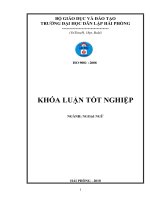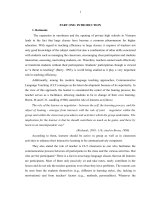Study on helicobacter pylori infection in cirrhotic patients
Bạn đang xem bản rút gọn của tài liệu. Xem và tải ngay bản đầy đủ của tài liệu tại đây (73.76 KB, 5 trang )
Journal of military pharmaco-medicine no7-2018
STUDY ON HELICOBACTER PYLORI INFECTION IN
CIRRHOTIC PATIENTS
Duong Quang Huy*; Hoang Van Quan*
SUMMARY
Objectives: To evaluate Helicobacter pylori infection and its relation with severity of cirrhosis,
portal hypertension in cirrhotic patients. Subjects and methods: Prospective, cross-sectional
descriptive study was carried out on 65 cirrhotic patients at the Digestive Department,
103 Military Hospital. Diagnosing and evaluating severity of Helicobacter pylori infection at
gastric mucosa by histopathological method. Results: Prevalence of Helicobacter pylori in
cirrhotic patients was 47.7%. Among those, mild Helicobacter pylori infection was predominant
with 22/31 (71.0%) patients. There was no relationship between Helicobacter pylori infection
and severity of cirrhosis according to Child-Pugh classification, as well as several signs of portal
hypertension in cirrhotic patients. Conclusion: Helicobacter pylori infection was not popular in
cirrhotic patients and not impacted by liver dysfunction and portal hypertension.
* Keywords: Cirrhosis; Helicobacter pylori infection.
INTRODUCTION
Cirrhosis is a quite popular disease in
many countries in the world, including
Vietnam. Its main causes are hepatitis
B/C virus infection and alcohol abuse. It
tends to increase at present because rate
of people who have been infected with
hepatitis virus and drink alcohol and beer
excessively remains very highly [1].
There are two stages of cirrhosis:
Compensated phase is often asymptomatic,
followed by decompensated cirrhosis with
many complications of liver failure and portal
hypertension such as variceal heamorrhage,
hepatic encephalopathy, hepatorenal
syndrome, hepato-pulmonary syndrome…
Besides, along with the development of
digestive endoscopy for over 30 years, the
impact of cirrhosis on the gastrointestinal
mucosa is also increasingly recorded such
as portal hypertensive gastropathy (PHG),
gastric antral vascular ectasia (GAVE),
gastric erosion, gastric and duodenal ulcer.
Out of these lesions, PHG is the clinically
important gastric mucosal lesion (occurring
in more than 50% of cirrhotic patients)
because it may cause acute and chronic
gastrointestinal mucosal bleeding leading
to iron deficiency anemia and decompensation
of cirrhosis [3].
Cirrhosis causes changes in the structure
of the gastric mucosa and whether it affects
colonization of Helicobacter pylori (H. pylori)
at here or not?. What is the role of
H. pylori in the pathogenesis of gastric
mucosal lesions in cirrhotic patients?.
These issues have not been really interested
in researching in Vietnam. Therefore, we
conducted this study with aims:
* 103 Military Hospital
Corresponding author: Duong Quang Huy ()
Date received: 21/03/2018
Date accepted: 22/08/2018
119
Journal of military pharmaco-medicine no7-2018
To survey prevalence of H. pylori infection
at gastric mucosa and its relationship with
severity of cirrhosis and several symptoms
of portal hypertension in cirrhotic patients.
SUBJECTS AND METHODS
1. Subjects.
- The study was conducted on
65 cirrhotic patients who hospitalized and
treated at the Digestive Department,
103 Military Hospital from September
2016 to June 2017.
- The diagnosis of cirrhosis was made
by a combination of impairment of liver
function, presence of portal hypertension
and changes in hepatic morphology in
abdominal ultrasound.
- Exclusion criteria:
+ Primary or secondary hepatic malignancy.
+ Recent acute gastrointestinal bleeding
(within 2 weeks).
+ Intake of antibiotics (up to 1 month)
or prior therapy for eradication of H. pylori.
+ Treatment of proton pump inhibitors
drugs (within 2 weeks).
+ Contraindication for endoscopy.
+ Refusal of participation.
2. Methods.
- Study design: Prospective, crosssectional descriptive study.
- All patients enrolled in the present
study were clinically examined and
indicated the full laboratory tests to
determine hepatic dysfunction and portal
120
hypertension (ascites, splenomegaly,
abdominal wall veins).
- The severity of cirrhosis was assessed
using the Child-Pugh classification (1973).
- Upper gastrointestinal endoscopy
was performed for all patients at the
endoscopy room, 103 Military Hospital on
the machine Olympus EVIS EXTRA II
CV180. Determining and evaluating the
grade of esophageal varices according to
the Japan Society for Portal Hypertension
(2010): No varicose appearance (F0),
grade 1 (F1), grade 2 (F2), grade 3 (F3)
[1].
Two biopsy specimens were taken from
gastric antrum and body for histopathologic
examination. The specimens were preserved
in formaldehyde solution (10%) and were
stained by Giemsa and Hematoxylineosin stain. On optical microscope with
magnification 1,000 times, H. pylori is
bacterial plaque (S or C - shaped) with
1 to 6 hairs in the head, locating in the
mucus layer or in the interstitium between
gastric mucosal epithelial cells [5].
- Evaluating severity of H. pylori
infection on histopathology according to
Polat F.R (2012) [5]:
+ Mild H. pylori infection (+): 1 - 10
H. pylori bacteria per area.
+ Moderate H. pylori infection (++):
10 - 30 H. pylori bacteria per area.
+ Severe H. pylori infection (+++): > 30
H. pylori bacteria per area.
- Statistical analysis: Statistical analysis
was made with the SPSS statistics version
18.0.
Journal of military pharmaco-medicine no7-2018
RESULTS
Table 1: Characteristics of age, gender, severity of cirrhosis and some signs of
portal hypertension in study group.
Patient characteristics
X ± SD or n (%)
Mean age
55.0 ± 11.2
Male
Gender
60 (92.3%)
Female
5 (7.7%)
Child-Pugh A
Severity of cirrhosis
Portal hypertension syndrome
12 (18.5%)
Child-Pugh B
26 (40.0%)
Child-Pugh C
27 (41.5%)
Splenomegaly
23 (67.6%)
Ascites
21 (61.8%)
Esophageal varice
(F1/F2/F3)
65 (100%)
(5.9%/38.2%/55.9%)
100% of patients had esophageal varices on doing upper gastrointestinal
endoscopy. Among those who had esophageal varices, grade 3 (F3) and grade 2 (F2)
were common. Our results were consistent with other studies in Vietnam which showed
that cirrhosis was more common in middle age, more males than females, and
admitted to hospital with severe disease which had complications [10].
Table 2: Rate and severity of H. pylori infection in cirrhotic patients.
H. pylori infection
n = 65
%
-ve
34
52.3
+ve
31
47.7
(+)
22
71.0
(++)
5
16.1
(+++)
4
12.9
Severity of H.pylori infection
(n = 31)
47.7% of cirrhotic patients in the study
were found H. pylori infection in
histopathology, among those, mild
H. pylori infection were the most common
(71.0%). In contrast, severe H. pylori
infection accounted for low percentage
with 12.9%. In fact, there are many
researches which determined rate of H.
pylori infection in cirrhotic patients. The
results showed that the prevalence of
H. pylori infection quite fluctuated. Abbas
et al (2014) studied 140 cirrhotic patients,
showed that rate of H. pylori infection
determined by histopathology and PCR
were 62.1% [2]. It was similar to result of
Safwat et al (2015) studying 80 patients
with hepatitis C virus-related cirrhosis
(60.0%) [7]. Evaluating rate of H. pylori
infection by serological method on
140 cirrhotic patients, Sathar et al (2014)
found that rate of H. pylori infection was
only 35.7% [8]. That was much less than
121
Journal of military pharmaco-medicine no7-2018
result of Tsai C.J (1998) (76.2%) [6]. The
reason there was significantly difference
between studies was that group of
selected cirrhotic patients was not
heterogeneous (differences from severity
of liver failure, portal hypertension,
causes of cirrhosis...) and especially the
method of determining H. pylori infection.
Rate of H. pylori infection in cirrhotic
patients in our study was significantly
lower than that of group without cirrhosis
in study of Nguyen T.L et al (2010)
(47.7% and 66.5%, respectively) [4]. This
finding has been explained by many
authors. The reason was that cirrhosis
made the gastric mucosa congested,
which can lead to anemia, degeneration
and necrosis of the epithelial cells. These
were unsuitable factors for the residence
and development of H. pylori [2, 7, 8].
Table 3: Relationship between severity of cirrhosis and H. pylori infection.
H. pylori infection
Severity of cirrhosis
-ve
+ve
Child-Pugh A (n = 12)
7 (20.6)
5 (16.1)
Child-Pugh B (n = 26)
13 (38.2)
13 (41.9)
Child-Pugh C (n = 27)
14 (41.2)
13 (41.9)
In view of the relationship between
severity of cirrhosis and H. pylori infection,
results of researches are conflicting. Safwat
et al (2015) showed the results which
were similar to our study, there was not
statistical significant difference in mean
Child-Pugh and MELD score between
cirrhosis group with and without H. pylori
infection (8.6 ± 1.7 vs. 8.5 ± 1.0 and
17.1 ± 6.2 vs. 19.4 ± 4.4, respectively,
p-value
> 0.05
p > 0.05) [7], while Abbas et al (2014)
found that there was significant difference
in rate of H. pylori infection between
severity of cirrhosis according to ChildPugh classification (p = 0.002) [2]. The
above controversial results suggest that
further prospective studies with a large
number of patients are needed to validate
the association between H. pylori infection
and severity of cirrhosis.
Table 4: Relationship between H. pylori infection and signs of portal hypertension
syndrome.
Portal hypertension syndrome
Ascites
Splenomegaly
Grade of esophageal varices
122
H. pylori infection
-ve
+ve
Absent
13 (38.2)
13 (41.9)
Present
21 (61.8)
18 (58.1)
Absent
12 (35.3)
17 (54.8)
Present
22 (64.7)
14 (45.2)
F1
2 (5.9)
7 (22.6)
F2
13 (38.2)
7 (22.6)
F3
19 (55.9)
17 (58.4)
p-value
> 0.05
> 0.05
> 0.05
Journal of military pharmaco-medicine no7-2018
Portal hypertension is one of the most
important factors causing structural changes
in the gastric mucosa. As a result, it might
affect the viability and development of
H. pylori [3]. However, our results did not
show a significant relationship between
some signs of portal hypertension (ascites,
splenomegaly, esophageal varices) and
H. pylori infection (p > 0.05) that was in
agreement with results of the previous
studies in the world [2, 7]. This showed
that pathogenesis of gastropathy in
cirrhosis, as well as colonization of
H. pylori in gastric mucosa is complex.
CONCLUSION
in cirrhosis. PhD Thesis in Medicine. Hue
University of Medicine and Pharmacy. 2014.
2. Abbas Z, Yakoob J, Usman M.W et al.
Effect of Helicobacter pylori and its virulence
factors on portal hypertensive gastropathy and
IL-8, IL-10 and tumor necrosis factor-alpha
levels. Saudi J Gastroenterol. 2014, 20 (2),
pp.120-127.
3. Eleftheriadis E. Portal hypertensive
gastropathy. Annals of Gastroenterology.
2001, 14 (3), pp.196-204.
4. Nguyen T.L, Uchida T, Tsukamoto Y et al.
Helicobacter pylori infection and gastroduodenal
diseases in Vietnam: A cross-sectional,
hospital-based study. BMC Gastroenterol.
2010, 10, p.114.
Studying H. pylori infection by histopathology
in 65 cirrhotic patients, we found that:
5. Polat F.R, Polat S. The effect of
Helicobacter pylori on gastroesophageal reflux
disease. JSLS. 2012, 16 (2), pp.260-263.
- Rate of H. pylori infection in cirrhotic
patients were 47.7%. Among those, mild
H. pylori infection was common with 22/31
(71.0%) patients.
6. Tsai C.J. Helicobacter pylori infection
and peptic ulcer disease in cirrhosis. Dig Dis
Sci. 1998, 43 (6), pp.1219-1225.
- There was no relationship between
H. pylori infection and severity of cirrhosis
according to Child-Pugh classification,
some signs of portal hypertension in cirrhotic
patients.
REFERENCES
1. Tran Pham Chi. Study on the efficacy of
esophageal varices ligation plus propranolol in
the prevention of recurrent bleeding and
impacting on portal hypertensive gastropathy
7. Safwat E, Hussein H, Hakim S.A.
Helicobacter pylori in Egyptian with HCVrelated liver cirrhosis and portal hypertensive
gastropathy: Prevalence and relation to
disease severity. Life Science Journal. 2015,
12 (3), pp.168-172.
8. Sathar S.A, Kunnathuparambil S.G,
Sreesh S et al. Helicobacter pylori infection in
patients with liver cirrhosis: Prevalence and
association with portal hypertensive gastropathy.
Annals of Gastroenterol. 2014, 27, pp.48-52.
123









